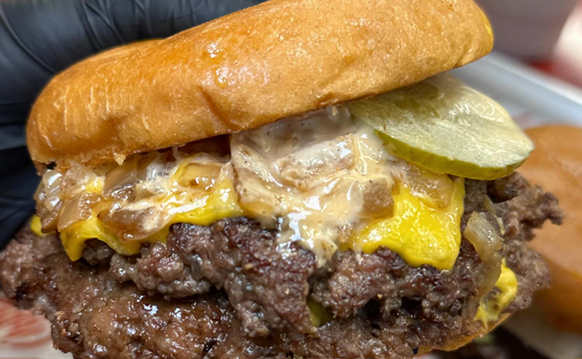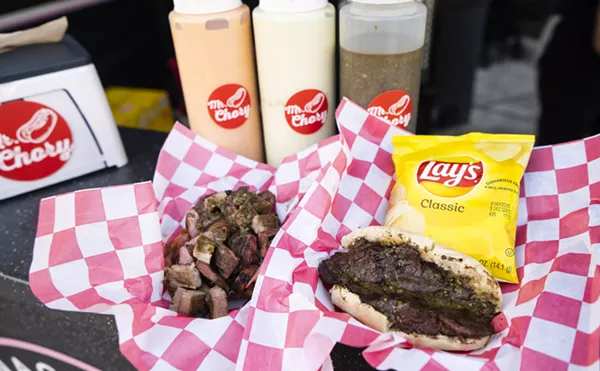Thai people have a similar reverence for mangoes. Their mamuang season, in the hot months of April and May, just before the deluge begins, is greeted with great good cheer. Thais use green mangoes in salads and chutneys or dip them raw into fish sauce, sugar, and chili powder; they eat ripe mangoes for dessert with sticky rice doused in coconut milk and palm sugar and sprinkled with sesame seeds; they make them into cheesecakes and milkshakes; and they jar and pickle whatever's left over. Thais also revere mangoes because the tree is associated with the Buddha (you'll find them planted around Buddhist temples). And until the climate changes significantly, it's a crop they can count on, as they have for thousands of years.
When you go to Thai Bayshore restaurant, you'll find all kinds of gently bustling joy around the news that they have fresh mangoes and sweet sticky rice for dessert. My advice is to get over there and have some now, because mango season, like life itself, is all too brief. This is a treat you shouldn't miss, whether it comes at the end of a full meal of pad Thai and squid basil or eaten solo as an afternoon pick-me-up.
A reader tipped me off to Thai Bayshore; his Thai wife swears by it. The restaurant is centrally located just south of Commercial Boulevard on Federal Highway; it's small enough (seating around 60) to be intimate, and it's family-run. The proprietors, from Bangkok, have been operating Thai restaurants locally for almost a decade, but they moved to their current location a little over two years ago. Husband Pat Siri runs the front of the house and helps in the kitchen; his wife, Nida, cooks; a daughter occasionally waitresses; the rest of the staff is tangentially related. The Siris have decorated this charming space with warm brick and honey-colored wooden floors, painted the walls deep maroon and butterscotch, and decorated sparsely with carved wooden screens, stately statues of the Thai Buddha, and a great stone relief sculpture, all chosen personally and shipped from Thailand. The wooden ceiling is deep black. A Buddha perched on his altar high on one wall appears to have been offered a glass of water. Hand-carved window screens hung along one side of the room are particularly beautiful, and the space is soothing, the soft lighting just right. Orchids nod from delicate painted vases on every table, lighted by candle lamps. A sound system plays unobtrusive classical piano music.
On our first visit, I made a big deal over the menu. I told Pat Siri that we were planning a trip to Thailand this winter (true) and asked for recommendations for traditional Thai food like "the foods we'll find in Thailand." I was hoping they'd serve us the most authentic flavors they could come up with. Our waiter recommended the tom yum kai soup ($2.95), the pad Thai ($10.95), and a basil sauce or curry with any choice of meat or fish (choose chicken, pork, beef, squid, shrimp, or scallops). We ate the soup and curry puffs ($5.95) as appetizers, squid with basil ($15.95) because squid can be difficult to render edible, and a "house special" seafood curry ($15.95) of shrimp, mussels, scallops, and squid with Thai curry paste and coconut milk. Thai Bayshore has a reasonably priced list of wines averaging around $22 a bottle, plus sake and Thai and Chinese beer, but we opted for a pot of tea.
Our little ploy worked beautifully, because every dish we tasted that night was stellar. State-of-the-art tom yum kai soup was served in an elegant geometric white bowl and was flavored with lemongrass, lime, a flowery note that I couldn't identify (maybe ginger), and supremely "chickeny" chicken pieces. Straw mushrooms and sliced scallions floated in the clear broth, and the effect was hot, sour, spicy, earthy, floral, and absolutely delicious.
Curry puffs were good too, a bit of chopped chicken, potato, and sweet potato mixed with curry powder, wrapped and fried in a spring roll, to be dunked in sweet cucumber sauce. These were basically yummy fast-food nibbles but without the mysterious complexity of the soup.
Plates were cleared; our gorgeous entrées arrived. A lot of care had gone into their presentation. Fresh vegetables and thumb-sized rolls of squid meat were piled artfully in the center of a white plate, decorated with Thai basil leaves and tiny bits of color from finely chopped red and green peppers. A long sprig of chive added a strip of pale green. My seafood curry was just as pretty: a pale, apricot-colored coconut cream curry sauce in which four shrimp, four huge mussels, four scallops, and lots of squid rolls had been arranged with bamboo shoots and super-thin strips of carrot. A dish of fragrant, moist white rice was served on the side.
Lovely to look at, they made even better eating. The vegetables in the squid basil curry were zesty, varied, full of crunch: thinly sliced onions, chopped green beans, snow peas, zucchini, slivers of carrot, red peppers, and green peppers, tossed with the gently licorice-scented Thai basil leaves, garlic, chili pepper, and tender, savory squid, toothsome but never tough. The sauce was piquant and quite hot from the chilies. My curry was just as pleasurable, rich, creamy, and layered, most generous with the seafood. I don't much like the big mussels served at Thai restaurants; they're too gamey. But shrimp, scallops, and squid were all damned fine representations of their species, each clearly and cleanly flavored with its own shrimpness or scallopness or squidness. Both these dishes were terrific, and there was lots left over to take home and reheat the next day.
As noted, the mango/sticky rice dessert was a grand finale. I'm not sure which variety of mango we were served, but it was finely textured and aromatic, and it married in a lovely way with the sweet coconut-milk-flavored rice ($6.95).
I took my father back the following week. He traveled in Thailand last year, and he loves Thai food. He's also one of the few people I know willing to eat frog legs (Thai Bayshore serves them three ways: with garlic, basil, or curry sauce, for $15.95), and I knew he'd go for them. As predicted, he did, ordering them in curry. I wanted pad Thai. And we decided to try tiger's tears salad ($6.95) and Eskimo shrimp ($6.95) as starters.
This time around, we didn't fuss to our waiter about how we wanted "authentic Thai." We just ordered, and the food we were served was blander, sweeter, and less complex. Was it a fluke? Or was somebody looking out for our digestive systems? Maybe these dishes were just inherently less spicy.
The tiger's tears, your basic Thai beef salad, had delicious flavor — ground spices, lime, and onions, but the beef was tough, chewy, really hard to cut. Red and green peppers were fresh, but a tomato was cardboardy and tasted vaguely of bleach. Wonton-wrapped and fried Eskimo shrimp ($6.95), advertised as stuffed with ground chicken and crab, had almost none of either — or just a pinch so small as to add zero flavor.
My pad Thai was, again, beautifully presented. Nida Siri is a plate artist. An enormous mound of silky noodles was tossed in salty-sour fish sauce, sprinkled with ground peanuts, and generously larded with chicken and shrimp. I asked for lime wedges, and a squeeze or two sharpened up the flavors. My father's frog legs were tender, and there were lots of them. But he wanted more spice in the coconut curry sauce and finally pronounced them too bland. Customers came and went in a steady stream. A Thai family came in, an American guy with a Thai woman, and an old Thai gentleman who sat by himself. Young people drifted in and out with big bags of takeout, and elderly ladies in groups ordered chicken cashew and chili fish — a deep-fried whole snapper with hot pepper and garlic sauce. On both visits, we'd eaten like kings and spent $64 with tip and tax.
If I lived nearby, I'd gleefully take on the challenge of eating my way through this menu — from fried rice to sweet and sour whole fish and the bayshore duck, but I'd do it asking for "spicy" and extra lime wedges. I'd let the Siris know I was no faint-palated weakling. I hardly blame them for trying to please the less courageous eaters who may be regulars here — but I know they can punch it up when they want to. So if you're a purist, tell them you want to eat like a Thai. My instincts tell me they'll be way happy to provide.











